Fans of livebearers flock to add fancy guppies (Poecilia reticulata) to their nano aquariums.

With over 300 varieties of colors, sizes, and tails to choose from, guppies make the perfect additions. They’re friendly little fish, creating colorful and active displays.
And when it comes to breeding projects? Guppies may be the easiest freshwater fish to breed!
You only need to pop a male and female into the same tank to yield baby guppies. (Maybe not even that)
Pregnant female guppies may deliver within days of entering the aquarium.
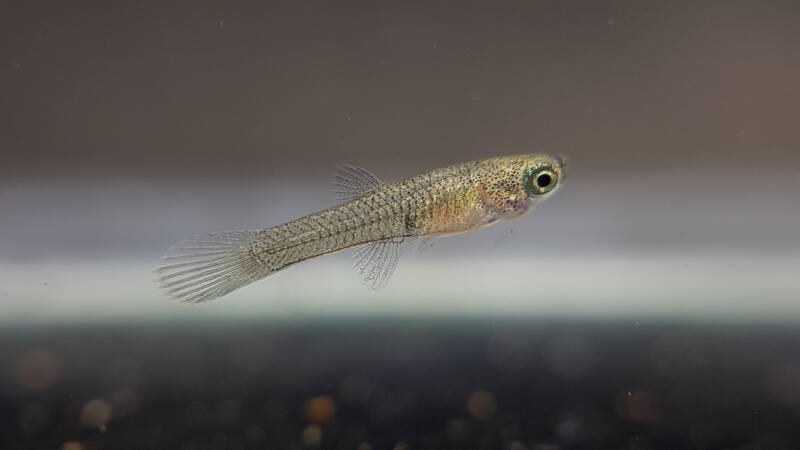
However, if you want to ensure healthy, happy guppy adults and babies, you’ll need to invest a little more care.
It’s a project novice aquarists can handle – provided you can set aside time and resources. With the work, though, you’ll soon have your guppy breeding operation.
At a Glance
| Minimum Tank Size: | 10 gallons (38 l) |
| School Size: | 4 (1 male and 3 females) |
| Temperature: | 72-82°F (22-28°C), optimum is 80°F (26°C) |
| Lifespan: | 5-7 years |
| Size: | 0.6-2.4 inches (1.5-6.0 cm) |
| pH: | 6.5-8.0 |
| Hardness: | 4-7 dH |
| Ammonia: | 0 ppm |
| Nitrite: | 0 ppm |
| Nitrate: | <20 ppm |
In this article
In the Wild
Guppies were discovered in Trinidad in 1866 by Robert John Lechmere Guppy. (Which is where their name came from)
He took one back to the British Museum for ichthyologists to examine, and they received the original name of Girardinus guppii.
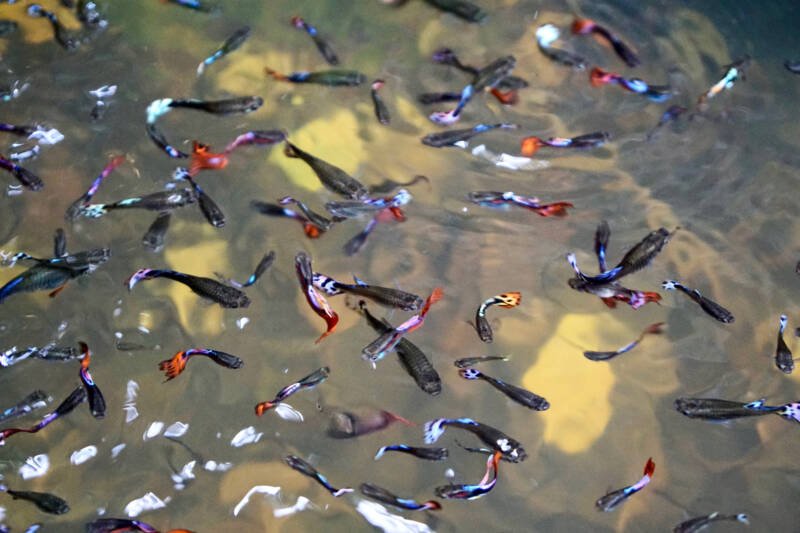
As often happens in the fish world, they underwent a few name changes before settling on their current classification.You can find them listed as rainbow fish in some pet stores due to the dazzling array of colors their selective breeding has produced.
Or you’ll see them under the name millionfish. Why? Because they’re so insanely successful at breeding!
Unfortunately, that prolific habit caused problems when they got released in Asian waters as a potential mosquito control option.
The guppies weren’t interested in the mosquitos. They DID outcompete the native fish populations, though.
It was a pattern repeated when the eastern mosquitofish (Gambusia holbrooki) followed in their footsteps later. (So much for natural pest control)
Size: Little Stunners
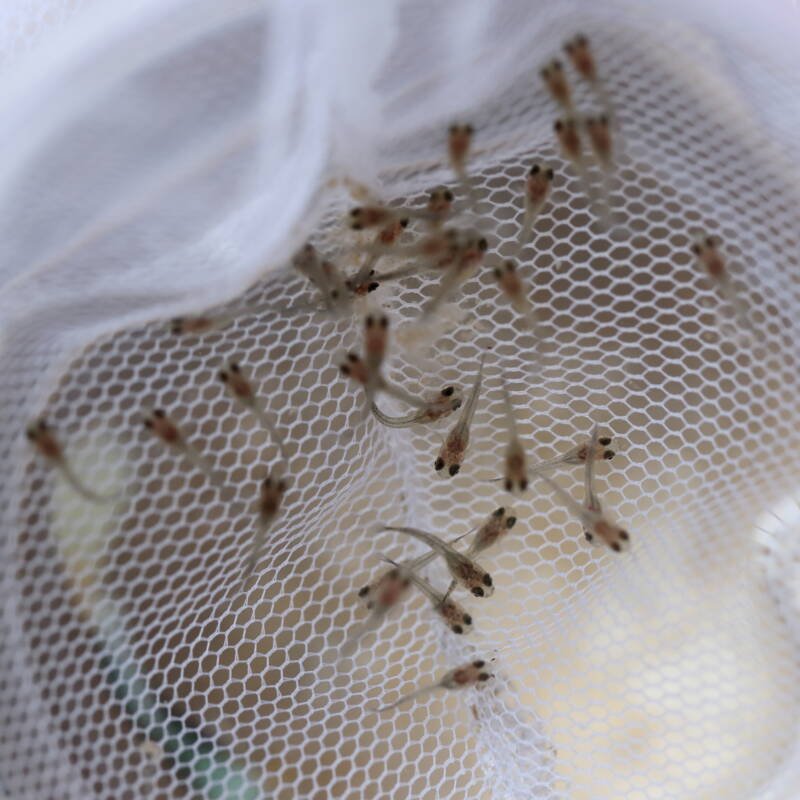
Guppies come in every color of the rainbow – if they’re a male.
Surprisingly, the males are half the size of their female counterparts. Perfect for nano aquariums, males grow to about 0.6-1.4 inches (1.5-3.5 cm) as adults.
In contrast, females have more drab appearances. They focus their energy on incubating the 10-400 baby guppies they’re often carrying! This is why they reach more impressive lengths of 1.2-2.4 inches (3.0-6.0 cm).
Lifespan
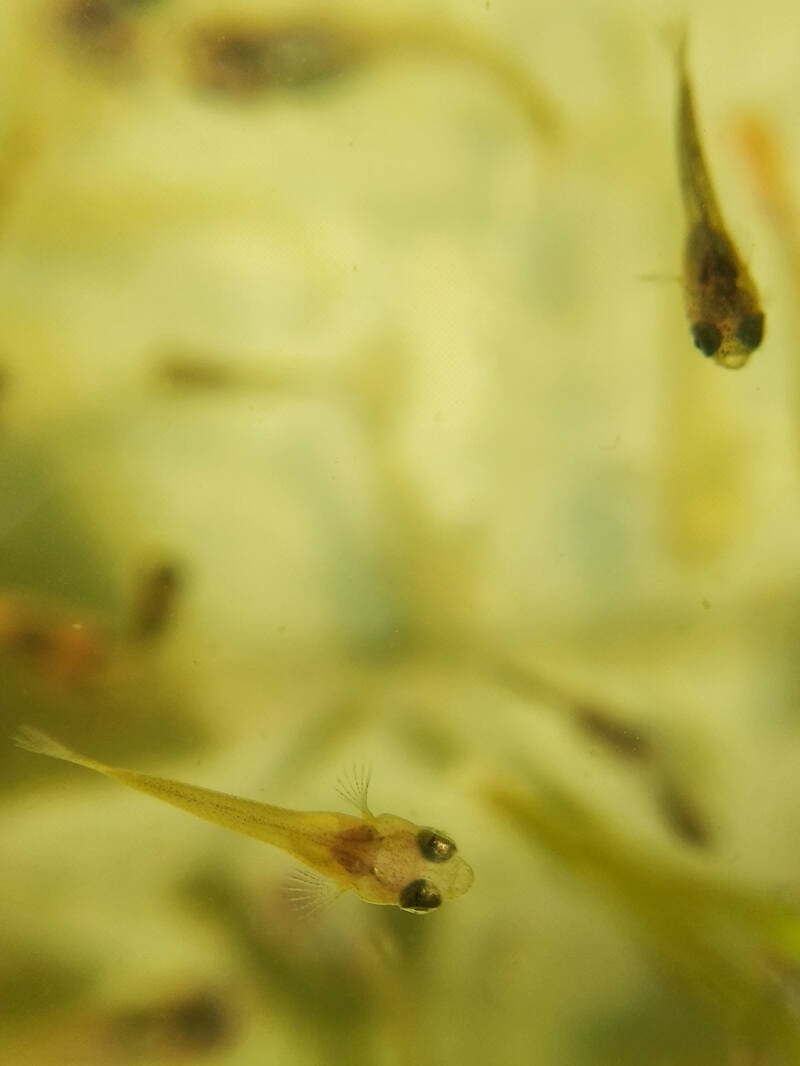
Considering their small size and the energy spent on reproduction, most livebearers (such as mollies, platies, and swordtails) have longer lifespans.
Guppies are no exception: you’ll see an average of 5-7 years for your colorful fry factories.
Guppy Fry Behavior
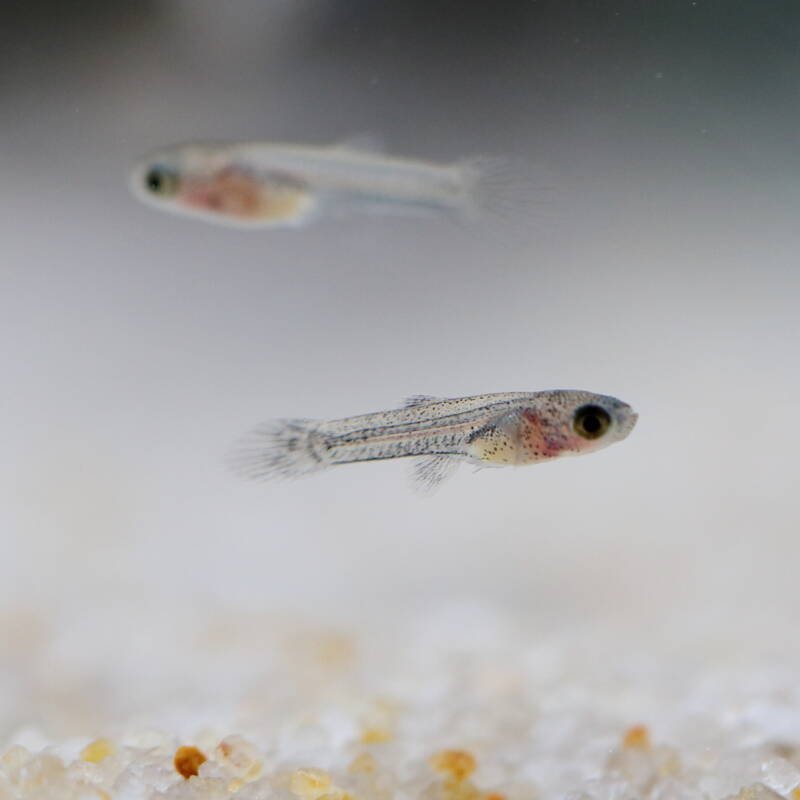
Guppies are active fish. They swim throughout the water column, paying attention to anyone who might offer them food. You need to take care not to overfeed them as a result of the “begging” behaviors.
When setting up a guppy breeding operation, it’s essential to choose the correct “school” situation.
Guppies do fine on their own, but pairings can get out of control if the ratios are off. The best rule is two to three females for every male.
If you have too few females, they end up harassed by the male. She’ll get nipped and continuously teased. Three females, in particular, calms the male down and reduces breeding strain. And a relaxed female ensures better success for your guppy babies.
Once your pregnant female’s ready to go into labor, you’ll notice some key behaviors. Depending on the tank set-up you choose, you must watch to decide when to move her. (Or it’ll help you know when to hunt for fry)
- You may struggle to find her as she tries to hide
- She’ll demonstrate shivering motions along her body (i.e., contractions)
- Her gills will move in rapid breathing
Similarly, once you have baby guppies within the tank, you may wonder why they’re collecting on the bottom.
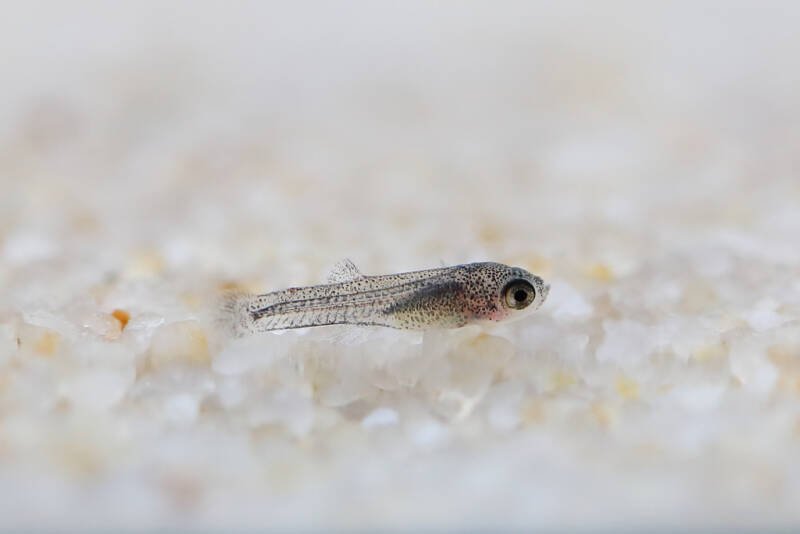
If you don’t have the proper décor, your fry will avoid the upper water column where the adults hang out. It’s hiding behavior. (And a sign you need to work on the tank)
Tank Setup

When you’re breeding guppies, you have a couple of options for your tank setup.
You can use a separate tank for the breeding process, you can add a breeding box to your existing tank or decide to use a single tank the entire time. Each option has its pros and cons.
| Setup | Pros | Cons |
| Separate Tank | Fry stay safe from adults | Need to set up and manage two tanks; Expensive |
| Breeding Box | Fry stay safe from adults; No need to regulate separate tanks | Unattractive; More in cost |
| Single Tank | No need to regulate separate tank; More attractive; Inexpensive | Fry may get eaten |
Whichever route you choose, make sure you invest in a quality heater.
The proper temperature keeps your baby guppy metabolism healthy, so they grow at a healthy rate. It also eases labor pains for your pregnant females.
Water quality is critical for guppy fry. They have poor immune systems in the first month of their lives. You’ll carry out frequent water changes, but you should also make sure you have the proper filter for your chosen tank so they don’t succumb to disease.
To boost the survival of your baby guppies, include an air stone in the tank. They need as much oxygen as possible during their development. The agitation from the outflow of the filter is NOT sufficient; add an air stone.
And while lighting may or may not occur to you, it’s a critical part of guppy growth. Baby guppies need light for 12-16 hours every day to prevent spinal deformities.
Follow it with 6-8 hours of darkness for proper sleeping time. If you’re forgetful, consider an automatic timer.
Water Conditions
Guppies are tropical species, but guppy fry have a specific water temperature need. You want 80°F (26°C).
You’ll encourage healthy eating and digestion at that target temperature. It’ll also ease the abdominal muscles of your females during labor. (It’s a kind gesture)
Guppy fry want water as neutral as possible. You can get away with a pH range of 6.5-8.0, but the optimum sweet spot is 7.2.
And while they’ll handle softer water, they prefer the range of 4-7dH. Remember, you want to baby them as much as possible (pun unintended).
Adult guppies may handle some fluctuations in water quality, but babies? They don’t have the immune systems. You need to perform 50% water changes twice a week. That will prevent ammonia and nitrites from forming (keep them at 0 ppm).
Decoration
If you use a breeding box, your guppy fry will remain safe and protected from the adults and other fish in the aquarium.
However, if you set up a separate breeding tank or leave the baby guppies in the same tank, you want to provide plenty of hiding places.
Adult guppies WILL cannibalize their young. That means providing plenty of hideouts for the fry to feel safe.
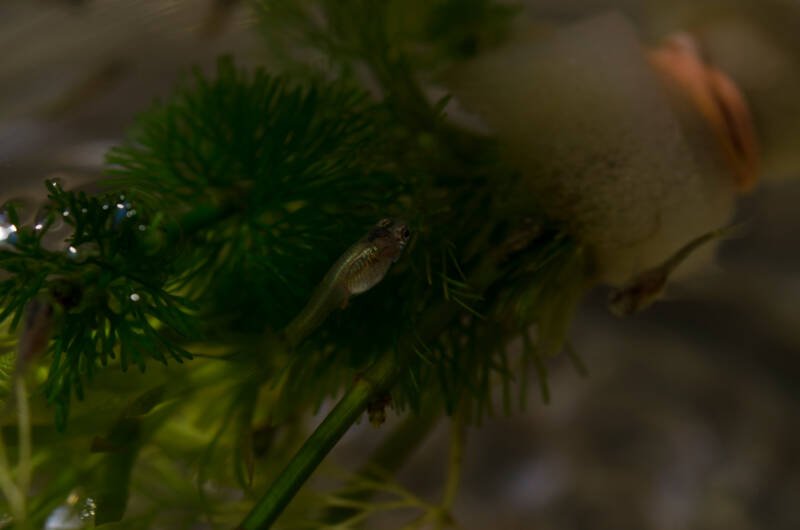
Floating and live plants give guppy fry options for protection – at both ends of the water column. Good choices include:
- Guppy grass (imagine that)
- Hornwort
- Java moss
- Water lettuce.
Guppy Fry in Communities
Guppy fry are the perfect size for snacking. If you decide to incorporate guppies into a community aquarium, consider using a separate breeding tank or breeding box to protect your baby guppies until they’re large enough to escape possible predation.
Tank Mates
In nano aquariums, guppies work well with fish of a comparable size and temperament. You can match them up with a couple of invertebrates, too.
Just make sure you take measures to protect the babies from becoming snacks.
- Bristlenose plecostomus
- Cherry shrimp
- Kuhli loach
- Nano rasboras
- Nerite snails
- Otocinclus
- Small corydoras, like pygmy.
Incompatible Species
With a peaceful temperament and small size, it’s not a good plan to introduce guppies – adults OR babies – into community tanks with large, aggressive fish.
Even slower angelfish can snatch up an adult guppy without pausing. You’re better off with a smaller set of scales.
Food and Diet
Compared to adult guppies, newborns come out at 0.2 inches (6 mm). So guess how small their mouths are!
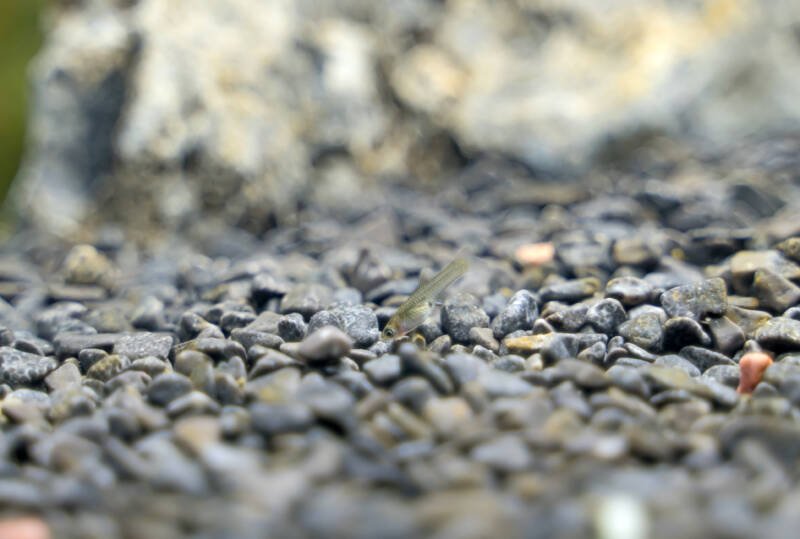
But, much like their parents, they live to eat. And since it only takes THIRTY MINUTES for them to digest a meal, they cruise around looking for their next meal.
You DON’T want to feed them every 30 minutes. However, feeding 5-10 times a day will encourage an excellent growth rate.
If you can’t fit that into your schedule, though, a once-daily feeding schedule won’t hurt your guppy fry. Provided you’re using the proper diet.
Baby guppies can eat the same omnivore diet as their parents. You just need to use a different scale. Powdered foods, such as Hikari First Bites, work fine. You can also crush up flake foods (think about those tiny mouths).
However, live foods do the best for your growing guppy fry. They have the most protein, which is what they need.
You CAN make a paste from hard-boiled eggs, but there’s a fair amount of fat in it (no more than twice a day). Live foods are better choices:
- Baby brine shrimp
- Daphnia
- Micro worms
- Vinegar eels
- White worms.
Breeding Your Guppies: Simple Livebearers
The ease of breeding guppies launched the popular varieties of the species.
People consider themselves hobby breeders or professional breeders, depending on how much time and money they invest into the process. And the fish? They kind of have the system down.
Males or Females?
When guppies reach the age of 3-5 months, they become sexually mature.
At that point, you can figure out whether you have males or females. (Which is helpful when you’re sorting out your resulting baby guppies)
Male guppies are half the size of females. They also have much brighter colors and patterns. As you get closer, you’ll notice the anal fin is longer and narrower. It’s modified into the gonopodium – the sexual structure they use to pass the spermatophore to the female.
Breeding Boxes
Whether you use a separate breeding tank, a breeding box, or let nature take its course, guppies are among the most successful livebearers.
Females tend to give birth every month until they reach the age of 2-3 years. And they can produce anywhere from 10-400 guppy fry.
During breeding, the male brushes against the female. Hooks on the end of the gonopodium catch onto her fin, holding him in place.He passes the spermatophore to her, where the packet splits open. The female can then store the sperm for up to FOUR MONTHS!
As the females prepare to give birth, she develops an almost-black gravid spot behind the anal fin. You’ll also see signs of labor.
It’s okay to keep multiple pregnant females together but think of the space. How many baby guppies do you anticipate? Will they end up too crowded?
Upon noticing those key labor behaviors, separating pregnant females grant them some peace and protect the newborn guppy fry.
The breeding tank needs to have the same water conditions as the main aquarium to prevent shock. (Breeding boxes avoid this problem)
In general, livebearers give birth during the evening hours. That isn’t a hard and fast rule, though. Guppies can go into labor at any point. That’s why it’s essential to monitor your pregnant guppies for the gravid spot and labor signs.
Guppy babies appear deformed and sluggish after birth. They’ve spent 30 days coiled up in a womb with how many siblings?
Gradually, over a few hours, they uncoil and begin to swim around. It’s essential to separate the motherso she doesn’t eat them.
There’s a catch, though. It can take HOURS for a pregnant guppy to finish giving birth to all of her babies. Some guppies take days. (If you have 400 fry, it’s going to be a while) You’ll need to pay close attention to when those contractions finish.
Guppy fry reach their adult size after two months. They need the proper care and a high-quality diet in the meantime. Not to mention freedom from the stress of lurking adult guppies. Make sure you offer those key hiding places.
If you’re using a separate breeding tank or breeding box, you can integrate your baby guppies into the community once they reach that critical age. They’ll have the speed to escape the adult fish, and they’ll present less of a temptation for snacking.
Health and Diseases
Because of their lack of a developed immune system, guppy fry can fall prey to many health concerns.
Staying on top of their water conditions is your best bet. You won’t have the option of adding medication to the water since dosing something that small is impossible.
In fact, if you don’t observe your tank, problems can start BEFORE the babies appear. If the water temperature falls, pregnant females get chilled. They can then end up with ich outbreaks. Watch your thermometer.
Without proper water changes or a filter on the tank, bacteria build up, and baby guppies start to fall ill to the following problems:
If you notice issues with one of your guppy fry, immediately remove it from the tank. You don’t want the disease to spread to the rest of the group.
Remember, they’re all in the process of developing their immune system! Untreated, they’ll quickly pass away.
Guppy Fry: Are They for You?
When you set out to start guppy breeding, you’ll find a range of pricing. Some guppies run for as little as $0.10 apiece.
If you want a fancier variety, you may pay as much as $25. It’s up to you where you want your breeding stock to begin.
As prolific breeders, though, you won’t need to worry about adding much to the mix.
Guppies are easy livebearers to keep and maintain. And as you combine different patterns, you’ll find yourself with stunning colors you can then turn around and offer to other guppy enthusiasts.
Caring for the Millions Fish
Breeding and caring for guppy fry requires some attention to detail. You need to note the behavior of the pregnant females and make arrangements for the guppy babies.
Once you have the knack, though, it’s an enjoyable hobby – or a lucrative business!
Do you breed guppies? What’s your favorite variety?
Do you use a breeding box or keep them in the primary tank?
Share your stories and questions with us here!